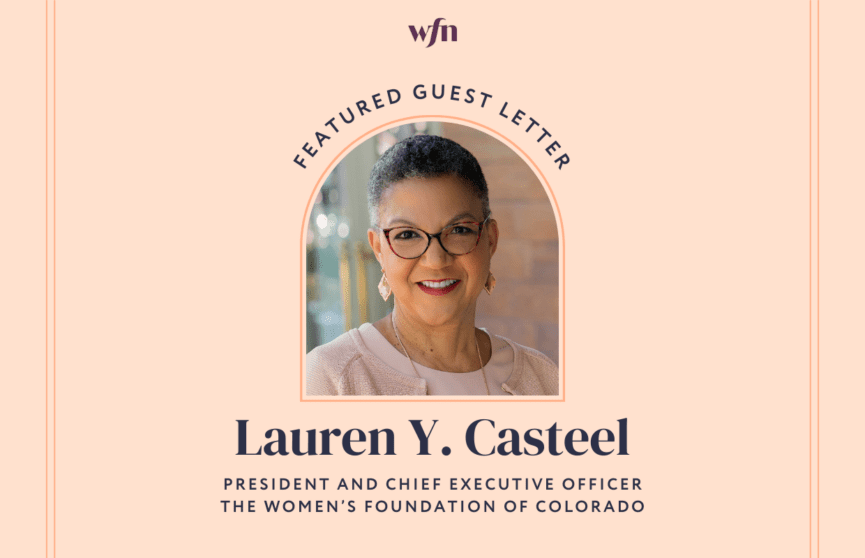Guest letter by Lauren Y. Casteel, President & CEO, The Women’s Foundation of Colorado
“The data is undeniable,” reports WFN’s Landscape Study of Women’s Funds and Foundations, Part I. “In study after study, pilot after pilot, mounting evidence demonstrates that women are fundamental drivers of economic growth – and women’s funds have the most intrinsic value to scale that growth, though they are continually undervalued by traditional philanthropy.”
It’s an exciting time in the evolution and relevance of women’s funds as evidenced by the intentionality of racial and gender equity in grantmaking, the adoption of advocacy, and the accelerating appointments of women of color leaders. I joined The Women’s Foundation of Colorado in 2015, and in that time, I have witnessed and been a part of building women of color leadership across US based women’s foundations in WFN, and we now make up over 50% of leaders, far outpacing most of philanthropy. These leaders bring candor, courage, and lived experiences that invigorate the sector.
The Women’s Foundation of Colorado, like many WFN members, was born to fight the feminization of poverty that came out of the shadows into the light in the 1980s. Regarded broadly as “ladies who lunch,” women’s funds were inspired and led mostly by rich white women and perceived – fairly or unfairly – as charity models or self-serving to assuage guilt. We were better known for our events than for our impact. Today, we continue to host fundraising events while we change systems.
As a Black woman CEO, it’s important to state that women’s funds haven’t always been committed to gender, racial, and economic equity. But the movement that struggled with inclusion and avoidance of controversy and uncomfortable conversations has learned and matured. If, as Melinda Gates recently said, “The agenda of our lifetime is making sure that women can take their full power in society,” then why do funders and major donors still not see that we are worthy of sustained, significant investment?
To own our rightful and deserved space within the philanthropic landscape, I offer the following recommendations to sister women’s foundations and funds and encourage you to add your own.
- Hold seats at local and national philanthropic decision-making tables. Ensure that conversations about wealth gaps, housing, healthcare, climate, education, care work, and food security include the perspectives of intersectional gender identities. Be visible and engaged in the halls of capitols working as credible, nonpartisan, and informed advocates for policies and coalitions that move women, children, and families forward. Initiate research, but also serve as constant reminders that gender is a criterion for all research and so is intersectional disaggregated data.
- Rigorously inform and adopt best practices of philanthropy. We’ve worked hard to position The Women’s Foundation of Colorado as a uniquely and equally valuable community foundation, although it took several years for our board and staff to embrace that identity. We met the criteria: the public support test, a place-based approach, community-led grantmaking, and holding donor-advised funds. Using all the tools available to a community foundation has earned us gravitas as a philanthropic institution and deep donor appreciation. Start where you can.
- Risk innovation and deep self-evaluation. Be curious if you are breaking the inherent imbalance of power rooted in transactional relationships. Ask grantee partners what they REALLY need and… trust them. Ask if you are willing to risk innovation through strategies, such as:
- Providing access to capital to the entrepreneurs most likely to be invisible and trusting women with flexible cash assistance
- Supporting undervalued organizations led by women of color and gender-expansive people
- Aligning investment portfolios with visions and missions
- Ensuring board and staff are reflective of the communities they serve
- Offering benefits that intentionally erase workplace inequities
- Designing evaluation tools upfront with grantees to ensure capacity to provide information about impact and equitable storytelling.
I also offer a recommendation for funders and sector partners, in addition to those on page 6 of the report. I was surprised to learn that private foundations account for 16% of member organizations, yet own 94% of the total grantmaking power of the network. An opportunity exists for private foundations who are WFN members to invest in place-based public women’s foundations.
If there’s anything we’ve learned since 2020, the fight for gender, racial, and economic equity is not yet won. I ask for your partnership in prosperity for generations to come. Trust us to know what’s best for the communities we represent. Trust us to lead, innovate, collaborate, and build power alongside you. The data is undeniable.
Lauren Y. Casteel
President & CEO, The Women’s Foundation of Colorado
